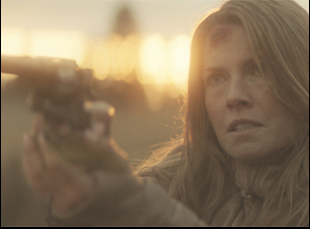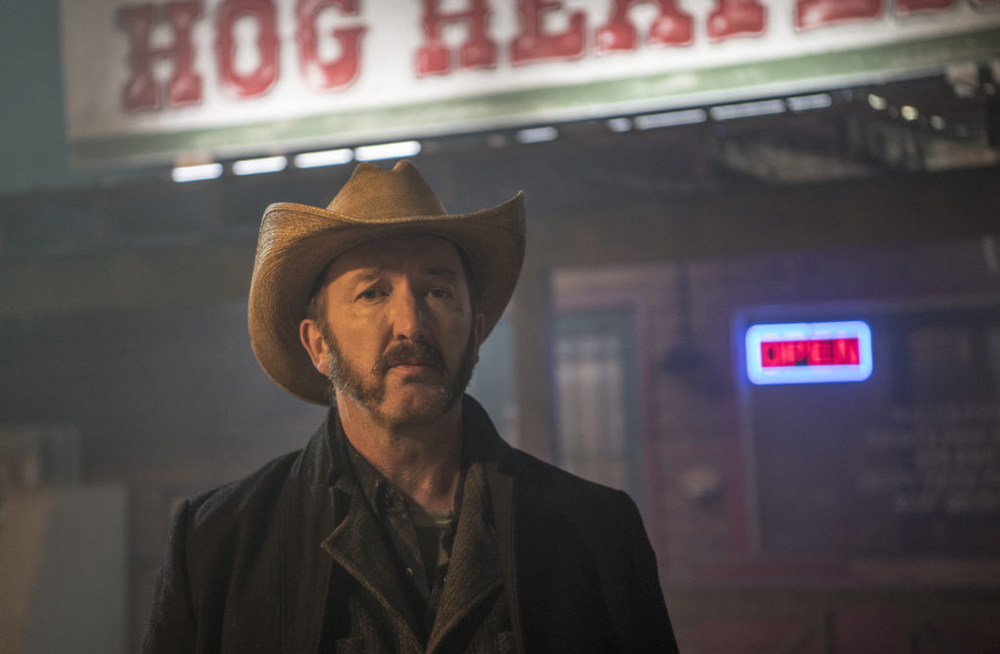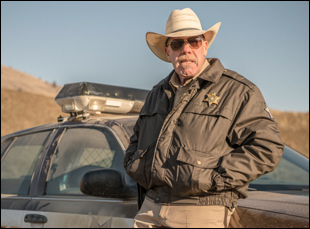There had already been some regional flavor in the script for “The Last Victim,” surely tickling the tastebuds of Ron Perlman who had been asked to play the laid-back Sheriff Hickey in the present-day western on a Friday and wasting no time getting back to producers on Saturday, knowing he’d be able to spice things up even more.
“His agent called and said, “Ron wants to do the film and he loves Sherriff Hickey,” said the film’s director Naveen A. Chathapuram, who had a surprise awaiting him on set. “And we did a Southern twist in the script, but when Ron came and he took it in and he started making it his own and added that little emphasis to it.”
Perlman’s drawn-out pronunciation of his deputy’s surname Gaboon (Camille Legg) as part of some light hazing becomes part of the charm of “The Last Victim,” in which Sheriff Hickey and his deputy are called to a diner in the least enchanted part of New Mexico where clearly a murder has been committed, but finding the body is going to require some investigation. What they don’t know, but the audience does is that a smooth-talking cowboy named Jake (Ralph Ineson) is going around settling scores and while Hickey and Gaboon actively search for him, an anthropologist (Ali Larter) and her husband (Tahmoh Penikett) are woefully close to crossing paths with him as they make their way through a national park, leaving one to wonder who will run into who first.
A traditional game of cat and mouse commences, but “The Last Victim” takes the road less traveled for the chase, passing through townships where the population can run as low as seven and as Jake fashions himself as a frontiersman, he can be seen as a relic who the world has passed by with everyone involved clinging on the life they know when the future doesn’t hold much promise. Still, the dire straits breeds a gallows humor and Chathapuram, a longtime producer making his first feature as a director, doesn’t shy away from highlighting the peculiarities of the locals while showing the same grit and determination as they do in crafting a thriller that sneaks up on you. On the eve of its release this week, the director spoke of the near-two-decade journey of “The Last Victim” to the screen and finding the right cast for it, as well as enduring freezing temperatures to make a film where justice is served up cold.
This came together in the first place when my uncle introduced me to someone named Dr. Neal Justin, an anthropologist based in Tucson, Arizona in 2002. I had just finished my first film as a producer and Doc and his wife invited me over to work on a movie and he brought three or four small little folders and one of them had the title “The Last Victim” on it. It was a throwback to films like “Deliverance” and “Breakdown” and he had a small little paragraph written and he said, “Let’s write a script, let’s budget this, let’s make this movie.” So I spent the whole summer writing the script, scheduling it and we were going to shoot it the next summer and Mount Lemon, our primary location, burnt down, so it got shelved. I went on this producing journey until I came back and said, “I want to direct my first film.”
When you returned to it, did your ideas about it change?
What ended up happening is I read the script and the original idea and the structure was good, but I knew it needed a rewrite to be brought to a modern-day take on it. I shortlisted Ashley James Lewis, my writer, from reading a bunch of scripts on the Black List and he had written a script called “Long Shadow at Noon,” and had a good voice, so I went to him, he wrote this [current] version of the script, which I loved. He had taken all the essence of the original and we stuck with the same kind of setting, which is the desert, southwest and the wilderness, but some of the specifics had changed. In the original, it [opens at] a feed store and in this, it went to a diner.
The idea of a part of America that’s been left behind seems especially resonant now. Was that always there?
Incidentally, one of the original themes that we were dealing with, both Ash and I, was isolation. I got introduced to the Southwest when I was 22, and until then, my life was in metropolitan cities like Chicago, New York and L.A. so it was a culture shock going into towns where there were only five people living there and to hear the kind of ideologies that were developing because they were totally isolated from society. When we built Jake’s character and all the people that live in this world, which is Bull, Tag and Camille, [they] were born out of that isolation and the aftermath of the American Dream where a major highway has moved somewhere else and all of a sudden, this thriving little town is now deserted. The few who stayed behind are the people who are there and their descendants, so that was always interesting and we leaned into that.
Ralph Ineson is great as Jake, but not the obvious choice as an Englishman. What was it like to bring him aboard?
I’m a big fan of “The Witch” and I’m always fascinated when I watch great films and certain actors blend into the world in every film they’re in and you forget that they’re an actor, so when it came to casting and I read Ashley’s version of the script, I had rewatched “The Witch” probably two months before that and I had watched the trailer for “The Witch” 200 times because of [Ralph’s] voice, so when I read the monologue, I read it in Ralph’s voice. When we got an initial [casting] list, he was on it and I saw he did “Buster Scruggs,” so I knew he could do a Southwestern American [accent], so he was the first actor we went to and he came on a Skype call and said, “Loved the script.” He broke the ice and [we] never looked back.
And for me, it’s a discovery process, so once you have the script, you’re discovering locations, you’re discovering looks with your [cinematographer], and casting was the same thing. It was discovering their ability to come into the role and I talked with Ralph a lot on prep, but once he gets it, it’s his own. I probably gave Ralph two sets of direction the entire movie. When he first got into the Bronco, I told him you have to think of it like Clint Eastwood getting onto a horse – it’s a metaphorical horse, so we would talk about that and he take it to the next level, [and generally] my goal was to create an environment where the actors can then be safe and be able to bring their own performance to the table.

There’s a good support system that she had and she was great with the makeup team, who provided a lot of support, and during the scene, it’s probably me and the DP who are her scene partners. Obviously, she’s a pro and she asked a lot of questions in prep. She was very specific about the beginning of the journey from when she’s alone to the third act, but one of the things that surprised me is how focused she was. The circumstances that we filmed this under were brutal. Some days, it was under subzero temperatures and you’re out in the wilderness and the nearest tent is a hundred yards away with a small propane heater, so Ali and Ralph, who are the two that spent the most time in the wilderness, used the cold to hone in on their performance and really bring it out.
After carrying this around in your mind for a couple decades, what’s it like to start to have the finished film out in the world?
I’m getting a lot of counseling from friends and crew members to learn how to let go. [laughs] Someone explained to me, it’s like a breakup and having your kid leaving for college, but at the same time you’re excited about it. I’m really looking forward to the release, and at the same time, although I have other projects that I’m working on, I don’t know what I’ll be working on in two weeks, so that’s a scary thought that I won’t have this film to work on.
“The Last Victim” opens on May 13th in New York at Cinema Village and in Los Angeles at the Monica Film Center. It is also available on AppleTV, Prime Video, Google Play and Vudu.





